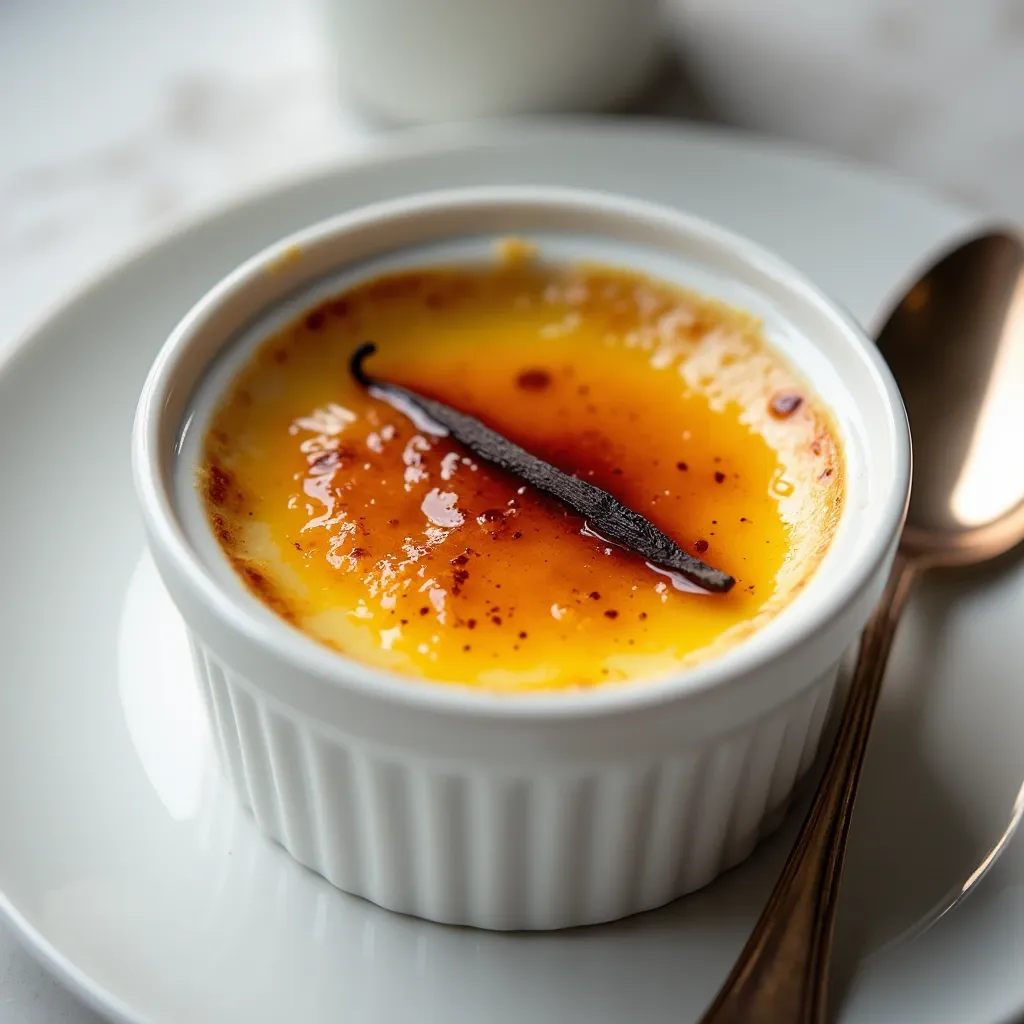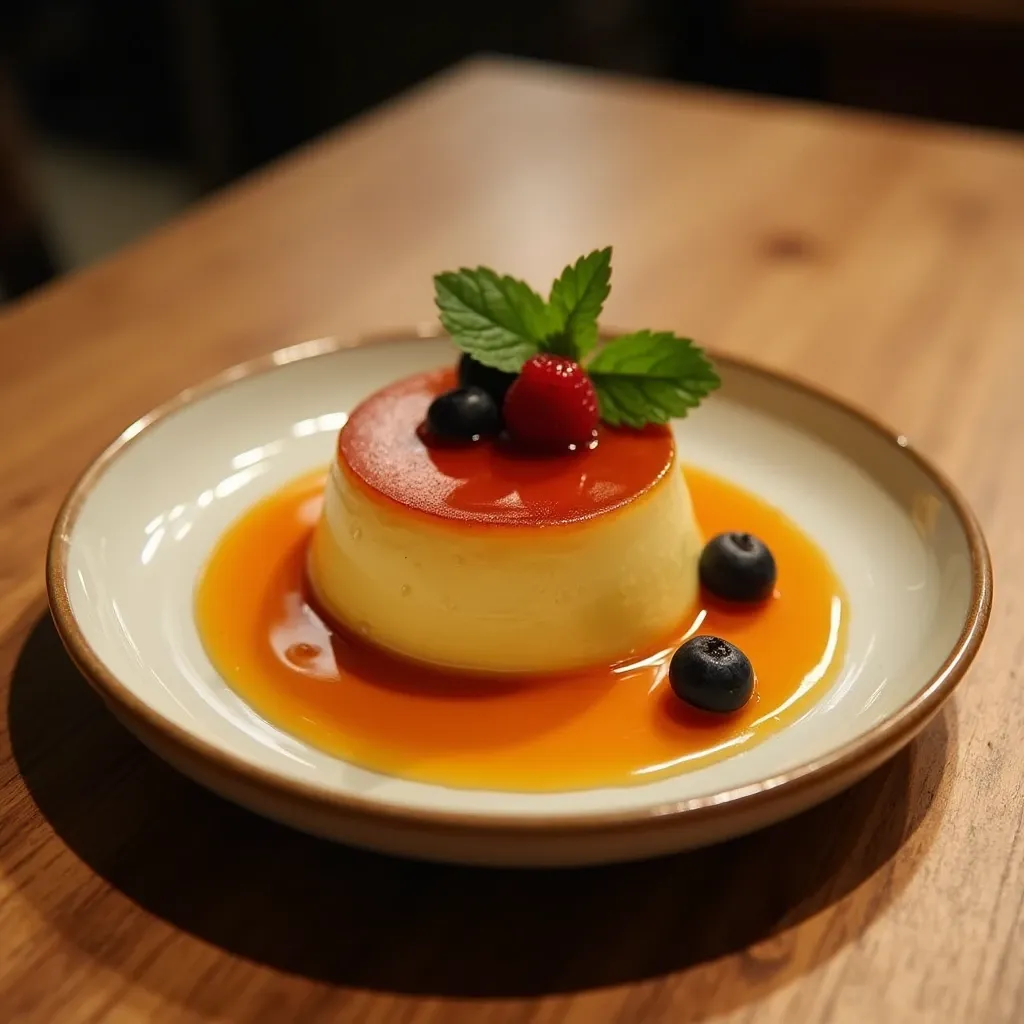In the world of custard desserts, crème brûlée and flan are top choices. They both have a smooth texture and rich flavors. But, they have different origins, ingredients, and ways of making them.
Crème brûlée comes from France and is known for its caramelized sugar crust. This crust breaks into pieces when you eat it. On the other hand, flan from Latin America has a soft, gooey caramel on top.
Both desserts are loved for their taste and texture. But, their unique cultural backgrounds and cooking styles make them special. They show the beauty of custard-making in different ways.
Understanding the Fundamentals of Custard Desserts
Custard desserts are loved for their smooth, creamy texture. They are made with eggs, sugar, and dairy. The exact ratio of these ingredients is key to their texture and taste.
Basic Custard Components
Eggs, mainly the yolks, are the base of custards. They give a rich, creamy feel. The dairy part, like cream, milk, or a mix, adds to the richness and creaminess. Sugar boosts the sweetness and affects the custard’s texture and setting.
Role of Eggs and Dairy
The mix of egg yolks and dairy defines different custard types. For example, crème brûlée uses more egg yolks and cream. Flan, on the other hand, has more milk and fewer yolks, making it lighter and more delicate.
Sugar’s Function in Custards
Sugar does more than just sweeten custards. It’s vital for their texture and setting. The sugar ratio determines the custard’s thickness and how long it takes to set. Getting the sugar balance right is key to the perfect custard texture and taste.
Origins and Cultural Significance

Both crème brûlée and flan have deep roots in European culinary traditions. Flan started in ancient Rome, seen as a health food. It then spread to Latin American countries, the Philippines, and the United States.
The history of crème brûlée is a bit unclear. France, England, and Spain all claim to have invented it. The first written record of it is in a 17th-century French cookbook.
Today, both crème brûlée and flan are loved worldwide. Flan is enjoyed in many places, like Mexico, Cuba, Brazil, and Japan. Crème brûlée is a favorite in European culinary traditions, known for its caramelized top and creamy inside.
The journey of flan from ancient Rome to today’s Latin American cuisine shows how food traditions evolve. In 1518, conquistador Hernán Cortés introduced flan to Mexico. Mexican cooks then added flavors like coffee and chocolate, making Mexican flan famous across Latin America.
Is crème brûlée basically flan? Key Differences Explained
Crème brûlée and flan are custard-based desserts, but they are not the same. They differ in custard consistency, egg-to-sugar ratio, and baking techniques. Crème brûlée is known for its smooth, creamy texture. This comes from using more egg yolks and heavy cream in the custard.
Flan, on the other hand, is firmer and jigglier. It often includes egg whites and sometimes gelatin. This makes it different from crème brûlée.
Texture Variations
The creaminess of crème brûlée comes from its egg-to-sugar ratio. This makes the custard richer and more luscious. Flan, with its lighter texture, has less sugar and includes egg whites.
This difference in custard consistency changes how they are served. Crème brûlée stays in its baking dish. Flan is flipped onto a plate, so the caramel sauce coats the dessert.
Cooking Methods
Both desserts are cooked in a water bath, but they use different techniques. Crème brûlée is baked at a higher temperature for a shorter time. Flan needs a longer, gentler cooking process.
Flan also needs to cool for a longer time before it can be unmolded. Crème brûlée can be served right after adding the caramelized sugar topping.
The Art of Making Crème Brûlée
Making the perfect crème brûlée combines French dessert techniques with art. It starts with a smooth custard base. This is made by whisking together cream, eggs, and vanilla until it’s like pudding.
The magic happens with the sugar top. It’s caramelized until it’s crisp and golden. When you bite into it, it shatters, adding a special touch to the dessert.
Creating crème brûlée is a time-consuming but rewarding process. It takes about 3-4 hours to make. First, the custard base is chilled. Then, the sugar topping is caramelized using a torch or broiler.
This step is what makes crème brûlée unique. It’s called “burnt cream” in French. The caramelized sugar adds a crunchy texture that contrasts with the creamy custard.
Classic Flan Preparation Techniques

Making the perfect flan is all about balance. It starts with a rich caramel coating. This is made by cooking sugar and water until it turns golden, creating a glossy base for the custard.
Traditional Caramel Making
To make the caramel, you need 1 cup of sugar and 1/3 cup of water. Heat it slowly, stirring now and then, until it’s a deep amber. Then, pour it into a dish and swirl it to cover the bottom and sides evenly.
Proper Cooling and Setting
The custard filling is made with eggs, evaporated milk, milk, vanilla extract, and sugar. Pour it over the caramel and bake in a water bath for 60-80 minutes at 350°F. Let it cool completely, which can take up to 6 hours. This slow cooling is key for the custard setting and the right flan recipe texture.
Signature Toppings and Presentation Styles
Crème brûlée and flan are two favorite desserts known for their special dessert presentation and serving techniques. Crème brûlée has a hard, caramelized caramel toppings that are torched right before serving. This creates a perfect contrast between the crunchy top and the creamy custard below.
Flan, on the other hand, is served with a thin layer of caramel sauce on top. This allows the custard to be easily flipped onto a plate or bowl. The caramel coating highlights the custard’s smooth, creamy texture, reflecting its cultural roots.
The unique ways these desserts are served add to their beauty and taste. Whether it’s the crunchy brûlée or the rich caramel sauce of the flan, these signature toppings and presentation styles make each dessert a special treat.
Popular Variations and Flavor Combinations
While vanilla is the most common flavor for crème brûlée, there’s a world of other tastes. Flan offers flavors like orange, chocolate, and coconut. These regional adaptations show how diverse custard-based desserts can be.
In Spain, crema catalana has cinnamon and citrus. Modern twists have brought us fusion and savory versions, like ancient Roman eel flan. The world of custard desserts is always evolving, introducing new dessert flavors for everyone to enjoy.
Common Mistakes and Troubleshooting
Making custard-based desserts like crème brûlée and flan needs focus and practice. Beginners often face issues like overcooked custards, grainy textures, and improperly set flan. Getting the right consistency and caramel flavor is a challenge.
It’s important to control the temperature when cooking and cooling. Custards cooked too hot can curdle or feel rubbery. Not using a water bath can cause cracking or uneven cooking. It’s essential to be patient when tempering eggs and letting the custard set fully.
Problems like lumps or streaks often come from bad mixing of starches. Paying attention to the ratio of eggs, dairy, and sugar is also key. With some baking tips and dessert troubleshooting, even beginners can make these creamy, rich desserts.
Tools and Equipment Essentials
Making the perfect crème brûlée needs a few key tools and baking gear. A kitchen torch is vital for caramelizing the sugar on top. This gives the dessert its signature crackling crust. Also, shallow, wide ramekins are essential. They provide the perfect space for baking the creamy custard.
Kitchen Torch Techniques
Learning to use a kitchen torch is critical for a great crème brûlée. Hold the torch at a slight angle and slowly move it over the chilled custard. This ensures the sugar caramelizes evenly. Stop when the sugar turns deep golden and crunchy.
Baking Vessels and Water Bath Methods
Water bath cooking is also key for the right texture in crème brûlée and flan. Use ramekins or shallow dishes in a water-filled pan for even heating. This makes the custard silky smooth. For flan, use caramel molds or flan pans to get the classic shape and caramelized top.
Conclusion
Crème brûlée and flan are both custard desserts, but they’re different in many ways. Crème brûlée has a crispy sugar top, giving it a French flair. Flan, on the other hand, is a base for many flavors from Latin America.
Making these desserts takes skill and patience. They’re great challenges for anyone who loves to cook. Whether you’re a home cook or a pro, mastering these desserts is rewarding.
Choosing between crème brûlée and flan depends on what you like and the event. Both desserts can make any meal special. They offer a mix of custard’s rich flavors and the right balance of sweetness and texture.

